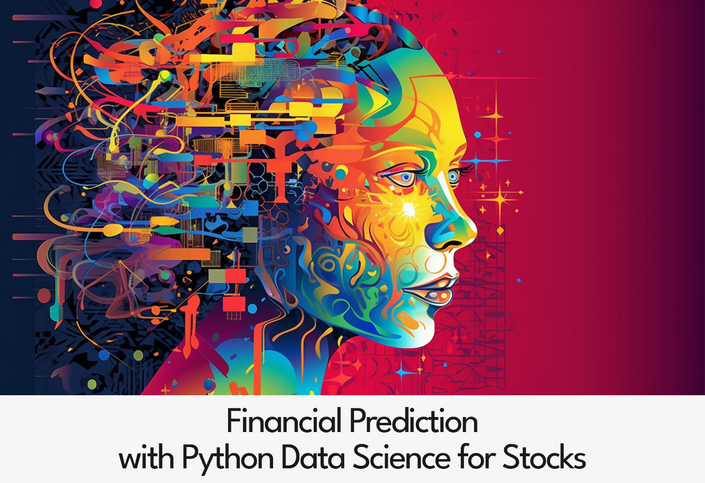
Financial Prediction with Python Data Science for Stocks (15 Hours)
Welcome to the Financial Prediction with Python Data Science for Stocks course! In this program, you will explore the exciting world of data science and learn how to leverage Python to analyze and predict stock market trends.
The course begins with an introduction to data analysis, where you will learn essential techniques for manipulating and exploring stock market data. You will delve into various Python libraries, such as pandas and NumPy, to clean and preprocess data, perform statistical analysis, and extract meaningful insights.
Next, you will discover the power of data visualization in understanding and communicating stock market trends effectively. Using libraries like Matplotlib and Seaborn, you will learn how to create compelling visualizations, including line charts, candlestick charts, and heatmaps, to analyze stock price patterns and identify potential investment opportunities.
The course also guides you through the process of building a stock ticker dashboard. You will learn how to fetch real-time stock market data using APIs, integrate it into your Python application, and create a dynamic dashboard that displays key financial metrics, market news, and stock performance.
Furthermore, you will explore different investing strategies and learn how to apply them using Python. From simple moving averages to more advanced techniques like Bollinger Bands and MACD, you will gain insights into how to build and evaluate investment strategies based on historical data.
Data science plays a crucial role in financial prediction, and this course equips you with the necessary tools and techniques. You will learn how to apply machine learning algorithms to predict stock prices and market trends. Additionally, you will discover the power of sentiment analysis by incorporating Twitter data. By analyzing public sentiment and news sentiment using Python libraries like TextBlob, you will gain insights into how social media can impact stock market behavior.
Throughout the course, you will work on hands-on projects and exercises that allow you to apply your newfound knowledge to real-world scenarios. By the end, you will have a solid understanding of data analysis, data visualization, stock ticker dashboards, investing strategies, data science, and Twitter sentiment analysis for financial prediction.
Join us on this exciting journey to master financial prediction with Python data science for stocks. By the end of the course, you will be equipped with the skills and knowledge to make informed investment decisions and harness the power of data science in the financial domain. Let's embark on this data-driven journey and unlock the potential of Python in the world of finance!
Your Instructor
John has been programming since 1997 and teaching since 2002. He has been contracted by many different companies to provide game design, audio, programming, level design and project management.
To this day John has contributed to 40 commercial games. Several of the games he has produced have risen to the Top 10 in the Apple's App Store.
His expertise is in e-learning, entrepreneurship, programming, software development, and game development. He is also a new father of two kids.
Mammoth Interactive is a leading online course provider in everything from learning to code to becoming a YouTube star. Mammoth Interactive courses have been featured on Harvard’s edX, Business Insider and more.
Over 14 years, Mammoth Interactive has built a global student community with over 8 million courses sold. Mammoth Interactive has released over 1,000 course and 5,000 hours of video content.
Founder and CEO John Bura has been programming since 1997 and teaching
since 2002. John has created top-selling applications for iOS, Xbox and
more. John also runs SaaS company Devonian Apps, building
efficiency-minded software for technology workers like you.
Course Curriculum
-
StartIntroduction (4:42)
-
StartVariables (19:17)
-
StartType Conversion Examples (10:04)
-
StartOperators (7:04)
-
StartOperators Examples (21:52)
-
StartCollections (8:23)
-
StartLists (11:38)
-
StartMultidimensional List Examples (8:05)
-
StartTuples Examples (8:34)
-
StartDictionaries Examples (14:24)
-
StartRanges Examples (8:30)
-
StartConditionals (6:41)
-
StartIf Statement Examples (10:16)
-
StartIf Statement Variants Examples (11:18)
-
StartLoops (7:00)
-
StartWhile Loops Examples (11:30)
-
StartFor Loops Examples (11:18)
-
StartFunctions (7:47)
-
StartFunctions Examples (9:16)
-
StartParameters And Return Values Examples (13:46)
-
StartClasses And Objects (11:13)
-
StartClasses Example (13:11)
-
StartObjects Examples (9:54)
-
StartInheritance Examples (17:26)
-
StartStatic Members Example (11:03)
-
StartSummary And Outro (4:06)
-
StartSource code
-
StartWhat Is Machine Learning (5:26)
-
StartTypes Of Machine Learning Models (12:17)
-
StartWhat Is Supervised Learning (11:04)
-
StartWhat Is Unsupervised Learning (8:17)
-
StartHow Does A Machine Learning Agent Learn (7:38)
-
StartWhat Is Inductive Learning (4:11)
-
StartHandle Noise In Data (5:22)
-
StartPowerful Tools With Machine Learning Libraries- (12:11)
-
StartPerformance Of A Machine Learning Algorithm (4:14)